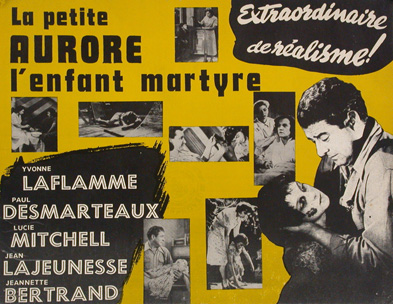
The Echoes

The events that took place in Ste. Philomène de Fortierville in 1920 inspired many publications, a play, novels, a television dramatization, a radio program, etc. In July 2005 a new motion picture was released; the film was an instant box-office hit, earning almost one million dollars in its first weekend in cinemas. Aurore has been an icon for many generations in Quebec. Children have long been told, "Stop acting like Aurore!" which means "Stop complaining for nothing!" One of the most fascinating "mysteries" around the death of Aurore Gagnon is that of how persistently it is remembered in the Quebec collective consciousness. With each new interpretation, the story changes, sometimes subtly, sometimes quite dramatically. This persistence and these transformations are of major interest to all those who are interested in the relationship between history and collective memory.
The first echo of this affair in Quebec popular culture was, of course, the "media circus" surrounding it, the coverage of the affair in French-Canadian newspapers being highly sensationalist. But it was a stage play put on in 1921 that entrenched the story of the Gagnons in the minds of Quebecers, at least until the 1950s. The play, Aurore, l’enfant martyre (Aurore the Child Martyr), written by Léon Petitjean, was produced not long after the tragedy. As of January 15, 1921 -- less than one year after Aurore died -- the Petitjean-Nohcor-Rollin troupe was putting on its two-act play in Montreal, with 6 actors. The play enjoyed notable success. It is estimated that there were over 5000 performances between 1921 and the 1950s.
Meanwhile, several Quebec novelists -- including Robert De Beaujolais, Yves Thériault and Hubert Pascal -- drew inspiration from the Fortierville tragedy. This was the case of Emile Asselin, whose novel La petite Aurore (Little Aurore) (1951) was used to write a screenplay in order to produce the film La petite Aurore l’enfant martyre (Little Aurore, the Child Martyr). The première of this film took place on April 25, 1952 and, even before its release, it was already considered a classic. Quebec cinema was only starting out and this melodramatic film was one of the first to achieve such success.
In French-speaking Quebec, the Aurore Gagnon affair is therefore a story everyone knows. But what explains the depth and the endurance of this cultural reference? What transformations has this story undergone in its progression from a farmhouse in Fortierville, through newspapers, theatres and sensational novels, all the way to Montreal cinemas? Precisely how far from historical reality is the story depicted in the play, the novels and the film, to the extent that this reality can be known by reading the newspapers and judicial documents of the time?
We therefore propose certain excerpts from a few of the numerous works inspired by the "strange death" of Aurore Gagnon in Fortierville in 1920. We invite you to compare them to one another, to assess them in light of the rest of our "virtual archives" and, especially, to think about the nature and formation of collective memory through time.